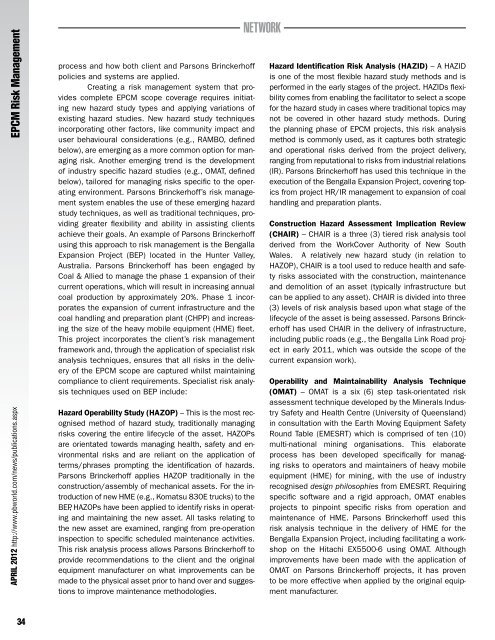Mining & Mined Caverns - Parsons Brinckerhoff
Mining & Mined Caverns - Parsons Brinckerhoff
Mining & Mined Caverns - Parsons Brinckerhoff
Create successful ePaper yourself
Turn your PDF publications into a flip-book with our unique Google optimized e-Paper software.
ePCM Risk Management<br />
APRIL 2012 http://www.pbworld.com/news/publications.aspx<br />
34<br />
process and how both client and <strong>Parsons</strong> <strong>Brinckerhoff</strong><br />
policies and systems are applied.<br />
Creating a risk management system that provides<br />
complete EPCM scope coverage requires initiating<br />
new hazard study types and applying variations of<br />
existing hazard studies. New hazard study techniques<br />
incorporating other factors, like community impact and<br />
user behavioural considerations (e.g., RAMBO, defined<br />
below), are emerging as a more common option for managing<br />
risk. Another emerging trend is the development<br />
of industry specific hazard studies (e.g., OMAT, defined<br />
below), tailored for managing risks specific to the operating<br />
environment. <strong>Parsons</strong> <strong>Brinckerhoff</strong>’s risk management<br />
system enables the use of these emerging hazard<br />
study techniques, as well as traditional techniques, providing<br />
greater flexibility and ability in assisting clients<br />
achieve their goals. An example of <strong>Parsons</strong> <strong>Brinckerhoff</strong><br />
using this approach to risk management is the Bengalla<br />
Expansion Project (BEP) located in the Hunter Valley,<br />
Australia. <strong>Parsons</strong> <strong>Brinckerhoff</strong> has been engaged by<br />
Coal & Allied to manage the phase 1 expansion of their<br />
current operations, which will result in increasing annual<br />
coal production by approximately 20%. Phase 1 incorporates<br />
the expansion of current infrastructure and the<br />
coal handling and preparation plant (CHPP) and increasing<br />
the size of the heavy mobile equipment (HME) fleet.<br />
This project incorporates the client’s risk management<br />
framework and, through the application of specialist risk<br />
analysis techniques, ensures that all risks in the delivery<br />
of the EPCM scope are captured whilst maintaining<br />
compliance to client requirements. Specialist risk analysis<br />
techniques used on BEP include:<br />
Hazard Operability Study (HAZOP) – This is the most recognised<br />
method of hazard study, traditionally managing<br />
risks covering the entire lifecycle of the asset. HAZOPs<br />
are orientated towards managing health, safety and environmental<br />
risks and are reliant on the application of<br />
terms/phrases prompting the identification of hazards.<br />
<strong>Parsons</strong> <strong>Brinckerhoff</strong> applies HAZOP traditionally in the<br />
construction/assembly of mechanical assets. For the introduction<br />
of new HME (e.g., Komatsu 830E trucks) to the<br />
BEP, HAZOPs have been applied to identify risks in operating<br />
and maintaining the new asset. All tasks relating to<br />
the new asset are examined, ranging from pre-operation<br />
inspection to specific scheduled maintenance activities.<br />
This risk analysis process allows <strong>Parsons</strong> <strong>Brinckerhoff</strong> to<br />
provide recommendations to the client and the original<br />
equipment manufacturer on what improvements can be<br />
made to the physical asset prior to hand over and suggestions<br />
to improve maintenance methodologies.<br />
Network<br />
Hazard Identification Risk Analysis (HAZID) – A HAZID<br />
is one of the most flexible hazard study methods and is<br />
performed in the early stages of the project. HAZIDs flexibility<br />
comes from enabling the facilitator to select a scope<br />
for the hazard study in cases where traditional topics may<br />
not be covered in other hazard study methods. During<br />
the planning phase of EPCM projects, this risk analysis<br />
method is commonly used, as it captures both strategic<br />
and operational risks derived from the project delivery,<br />
ranging from reputational to risks from industrial relations<br />
(IR). <strong>Parsons</strong> <strong>Brinckerhoff</strong> has used this technique in the<br />
execution of the Bengalla Expansion Project, covering topics<br />
from project HR/IR management to expansion of coal<br />
handling and preparation plants.<br />
Construction Hazard Assessment Implication Review<br />
(CHAIR) – CHAIR is a three (3) tiered risk analysis tool<br />
derived from the WorkCover Authority of New South<br />
Wales. A relatively new hazard study (in relation to<br />
HAZOP), CHAIR is a tool used to reduce health and safety<br />
risks associated with the construction, maintenance<br />
and demolition of an asset (typically infrastructure but<br />
can be applied to any asset). CHAIR is divided into three<br />
(3) levels of risk analysis based upon what stage of the<br />
lifecycle of the asset is being assessed. <strong>Parsons</strong> <strong>Brinckerhoff</strong><br />
has used CHAIR in the delivery of infrastructure,<br />
including public roads (e.g., the Bengalla Link Road project<br />
in early 2011, which was outside the scope of the<br />
current expansion work).<br />
Operability and Maintainability Analysis Technique<br />
(OMAT) – OMAT is a six (6) step task-orientated risk<br />
assessment technique developed by the Minerals Industry<br />
Safety and Health Centre (University of Queensland)<br />
in consultation with the Earth Moving Equipment Safety<br />
Round Table (EMESRT) which is comprised of ten (10)<br />
multi-national mining organisations. This elaborate<br />
process has been developed specifically for managing<br />
risks to operators and maintainers of heavy mobile<br />
equipment (HME) for mining, with the use of industry<br />
recognised design philosophies from EMESRT. Requiring<br />
specific software and a rigid approach, OMAT enables<br />
projects to pinpoint specific risks from operation and<br />
maintenance of HME. <strong>Parsons</strong> <strong>Brinckerhoff</strong> used this<br />
risk analysis technique in the delivery of HME for the<br />
Bengalla Expansion Project, including facilitating a workshop<br />
on the Hitachi EX5500-6 using OMAT. Although<br />
improvements have been made with the application of<br />
OMAT on <strong>Parsons</strong> <strong>Brinckerhoff</strong> projects, it has proven<br />
to be more effective when applied by the original equipment<br />
manufacturer.

















